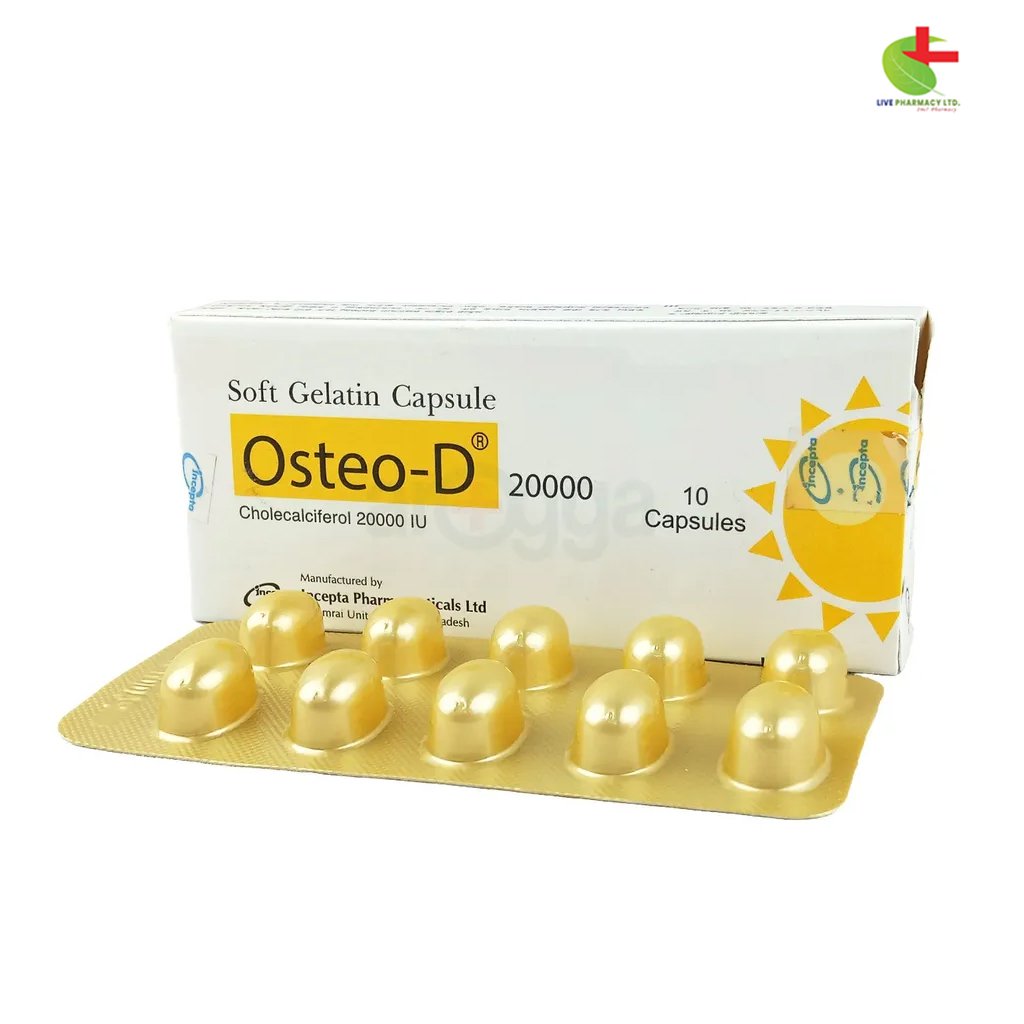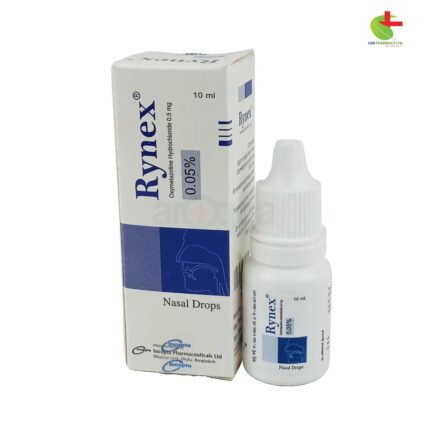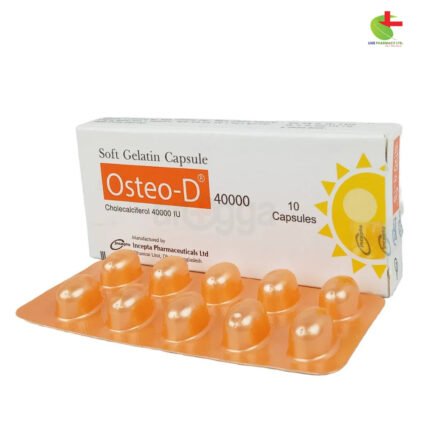Osteo-D 20000
200.00৳ Strip
- High-quality Vitamin D3 supplements vital for strong bones and a robust immune system.
- Ideal for those with limited sunlight exposure or dietary deficiencies.
- Carefully formulated for both adults and children.
- Ensure your health and well-being with trusted Vitamin D3 solutions!
 Brand
Brand
|
Incepta Pharmaceuticals Ltd |
|---|---|
 Generics
Generics
|
Cholecalciferol [Vitamin D3] |
 Type
Type
|
Capsule |
Indications
Vitamin D3 deficiency often arises in individuals with limited sunlight exposure or inadequate dietary intake of vitamin D3. This vitamin is crucial for the effective absorption of calcium and phosphate, essential for maintaining healthy bones and teeth. It helps prevent conditions like rickets, osteomalacia, and osteoporosis. Additionally, Vitamin D3 plays a vital role during pregnancy by reducing the risk of pre-eclampsia and is essential for nursing infants’ development. It also contributes significantly to enhancing immune function.
Pharmacology
The active form of Vitamin D3, known as Calcitriol, works by binding to Vitamin D receptors (VDRs) present in various body tissues. Being fat-soluble, Vitamin D3 has a half-life of approximately 50 days. It is absorbed in the small intestine, where it binds to specific alpha-globulins before being transported to the liver, where it is converted to 25-hydroxy Vitamin D3 (Calcidiol). The kidneys then further metabolize it to 1,25-dihydroxy Vitamin D3 (Calcitriol), which is responsible for increasing calcium absorption. Unmetabolized Vitamin D3 is stored in tissues like fat and muscle and is eliminated through urine and feces.
Dosage & Administration
For Capsules:
Adults:
- Treatment of Vitamin D3 Deficiency: 40,000 IU once weekly for 7 weeks. Maintenance therapy should be 1,400-2,000 IU/day, with a 25-hydroxyvitamin D level check 3-4 months after starting maintenance.
- Prevention of Vitamin D3 Deficiency: 20,000 IU every 4 weeks; higher doses may be needed in specific cases.
- Supplement for Osteoporosis Therapy: 20,000 IU once monthly.
Children (12-18 years):
- Treatment of Vitamin D3 Deficiency: 20,000 IU once every 2 weeks for 6 weeks.
- Prevention of Vitamin D3 Deficiency: 20,000 IU every 6 weeks.
For Film-Coated Tablets: 1000 IU (1-2 tablets) daily, or as directed by a physician. Take with food or within 1 hour after a meal.
For Chewable Tablets: 1000 IU to 2000 IU daily, or as directed by a physician. Consume with food or within 1 hour after a meal. Chew thoroughly before swallowing.
For Syrup:
- At-risk Patients for Cholecalciferol Deficiency:
- 0-1 year: 400 IU/day (2 ml)
-
1 year: 600 IU/day (3 ml)
- For Cholecalciferol Deficient Patients:
- 0-1 year: 2000 IU/day (+50,000 IU/week) for 6 weeks
- 1-18 years: 2000 IU/day for 6 weeks.
For Injections:
- Prevention:
- Infants on Vitamin D-enriched milk: ½ ampoule (0.5 ml) = 100,000 IU every 6 months.
- Non-enriched milk-fed infants or children up to 5 years: 1 ampoule (1 ml) = 200,000 IU every 6 months.
- Adolescents: 1 ampoule (1 ml) = 200,000 IU every 6 months in winter.
- Pregnancy: ½ ampoule (0.5 ml) = 100,000 IU starting from the 6th or 7th month.
- Elderly: ½ ampoule (0.5 ml) = 100,000 IU every 3 months.
- Vitamin D Deficiency:
- 1 ampoule (1 ml) = 200,000 IU, repeatable every 1 to 6 months, or as prescribed.
Use as directed by your healthcare provider.
Interactions
Several medications can cause Vitamin D3 deficiency by interfering with its absorption and metabolism, including magnesium-containing antacids, digoxin, thiazide diuretics, cholestyramine, cholestipol, phenytoin, phenobarbital, orlistat, and mineral oil. Corticosteroids like prednisolone may increase Vitamin D3 requirements.
Contraindications
Vitamin D3 is contraindicated in conditions associated with hypercalcemia. It should not be used by individuals with known hypersensitivity to Vitamin D3 or its excipients, or in cases of Vitamin D3 toxicity.
Side Effects
Potential side effects may include anorexia, fatigue, nausea, vomiting, diarrhea, constipation, weight loss, increased urination, sweating, headache, thirst, dizziness, and elevated calcium and phosphate levels in blood and urine.
Pregnancy & Lactation
Studies indicate that doses up to 4,000 IU during pregnancy are safe. The recommended daily intake for pregnant women is 400 IU, but higher doses may be necessary for those with deficiencies. Pregnant women should consult their healthcare provider for personalized advice.
Vitamin D3 and its metabolites are excreted in breast milk. While overdoses in nursing infants are rare, healthcare providers should consider any additional Vitamin D3 supplementation for breastfed children.
Precautions & Warnings
Regular monitoring of plasma calcium levels is advised for patients on high doses of Vitamin D3, particularly in those with renal impairment or during pregnancy and lactation. Individuals using digoxin or thiazide diuretics should consult a healthcare professional before starting Vitamin D3. Those with liver or kidney diseases, primary hyperthyroidism, lymphoma, tuberculosis, or granulomatous diseases should seek medical advice before supplementation.
Use in Special Populations
The safety and effectiveness of Vitamin D3 in children under 12 years have not been established.
Overdose Effects
Overdosing on Vitamin D3 can result in hypervitaminosis D.
Therapeutic Class
Vitamin D preparations are essential for bone health and formation.
Storage Conditions
Store below 30°C, protected from light and moisture. Keep out of reach of children.













Reviews
There are no reviews yet.